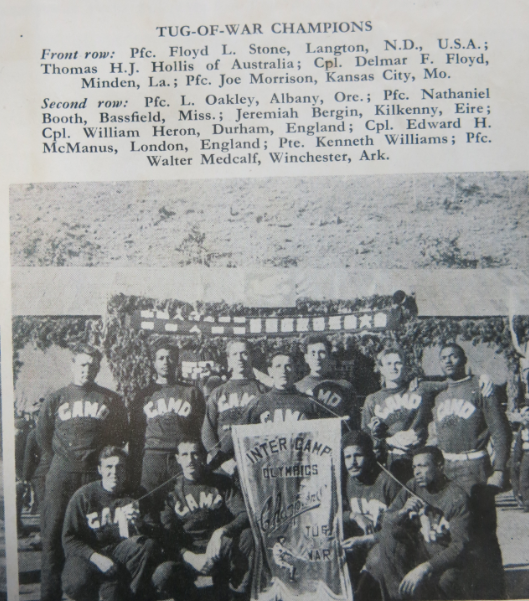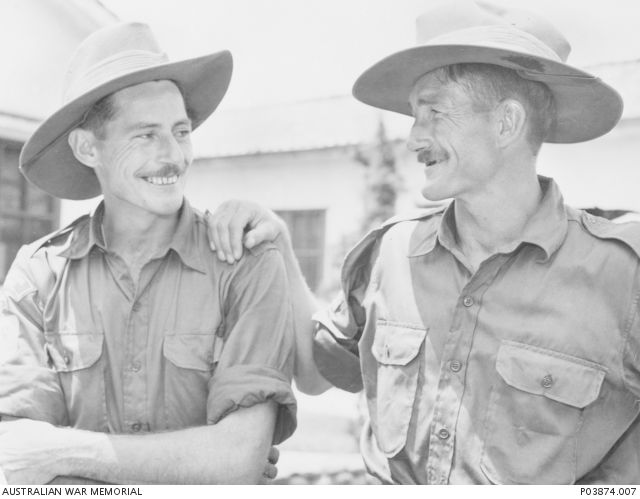The “Reactionaries”: Buck, Hollis, Madden, Parker and Gwyther
Chinese propaganda photograph: four Australian prisoners of war at Camp 5, Pyoktong, North Korea, wearing Chinese-issued padded uniforms. Left to right: Privates Bob Parker, Keith “Mo” Gwyther, Tom Hollis and Corporal Don “Old Man” Buck.
On 9 August 1953, Tom Hollis and Keith Gwyther shared a drink at Britannia Camp near Seoul in South Korea. The men had been released, as part of Operation Big Switch, after more than two years of captivity. Several days earlier their comrades Robert Parker and Don Buck had also been released. Thirty Australians of the Australian Army and Royal Australian Air Force were captured during the course of the war. Twenty nine were released between 9 February 1951 and September 1953; one died in captivity.
Privates Keith “Mo” Gwyther and Tom Hollis share a drink to celebrate their freedom at Britannia Camp, South Korea on 9 August 1953.
Private Hollis and Corporal Buck were among the first Australians to be taken as prisoners of war in Korea during a routine patrol by 3RAR at Ichon on 21 January 1951. The first Australian captured was Flight Lieutenant Gordon Harvey whose Mustang fighter aircraft force landed in North Korea after being hit on 19 January.
On 9 February, the other three members of the 3RAR patrol were released: Lieutenant Angus McDonald, Corporal Lawrence Buckland and Private Edward Light. Ted Light was the customs officer who greeted Hollis and Buck when they landed in Darwin after repatriation in 1953.
Privates Gwyther and Parker were captured during the battle of Kapyong on 24 April 1951 along with signaller Private Horace Madden. Parker had been shot in the hip while riding his despatch bike during the headquarters withdrawal. He was the despatch rider for the commanding officer of 3RAR, Lieutenant Colonel Bruce Ferguson. Madden had been stunned by Chinese mortar fire during the withdrawal and was also captured. Gwyther, stunned and buried by artillery, and left behind in D Company positions after the final withdrawal, had been reported as killed in action.
Parker and Madden were reunited at a Chinese position on top of a mountain during the battle, and were later joined by Gwyther who marched 150 kilometres to their camp. On 16 May, the three arrived at Bean Camp (known for only serving millet and soy beans at meal times) and found Buck. Hollis had been separated from Buck shortly after capture and force marched to Camp 5.
Madden was openly defiant towards his Chinese captors. His health rapidly declined as a result of the severe beatings he received as punishment, and he was moved to the Caves Camp at Kandong. After giving away his food to those worse off than himself, he died of malnutrition on 6 November 1951. He was posthumously awarded the George Cross in 1955 in “recognition of gallant and distinguished service whilst a prisoner of war in Korea”.
Parker, Gwyther and Buck were force marched to Camp 5 at the North Korean border with Manchuria in early June 1951. During the march Parker and Buck made a daring escape with a Frenchman but were re-captured 11 days later. Gwyther also escaped with an American but was recaptured shortly after and spent a month in a Pyongyang Prison. Parker and Buck were sent to Camp 12. Parker’s gunshot wound was treated in a hospital, and a Chinese nurse smuggled a note to his family through contacts in Hong Kong. In December 1951, Parker and Buck joined Gwyther and Hollis at Camp 5, where they remained for the rest of the war.
On 25 June 1952 – the second anniversary of the beginning of the war – Buck organised an escape. Twenty four prisoners escaped, including Parker, Gwyther and Hollis, but were re-captured several days later after another prisoner informed on them. Buck was identified as the ringleader and was heavily punished. The four Australians were dubbed “reactionaries” by their captors and subjected to punishment and re-education, including beatings, torture and spending over 12 hours a day in the sweat box for a month. This punishment came on top of the poor conditions experienced during captivity.
Inter-Camp POW Olympics
In November 1952, the Inter-Camp POW Olympic Games were held between the various camps at Pyoktong, North Korea. Over 500 prisoners participated in sports including track and field, basketball, gymnastics, boxing, wrestling, football, soccer, baseball and volleyball. Tom Hollis received a medal as part of the winning tug-of-war team.

Curatorial photograph of United Nations POWs in Korea, a propaganda book sent to the families of prisoners. This book was sent to Hollis’s wife.

Curatorial photograph of image from United Nations POWs in Korea. Hollis is front row, second from left next to the banner.
A basketball game between American and Australian prisoners of war played in 1953 as a propaganda match. The players are wearing singlets marked with the names of the teams: US Camp 1 Co and Camp 5 Co.
Tony the Greek
While in Camp 5 the Australians befriended a Greek Army forward observer Antonio Sandorinaios, affectionately nicknamed “Tony the Greek”, and taught him English. Before the war, he was a sponge diver from the port of Piraeus, Athens. Sandorinaios was one of the 24 prisoners who attempted to escape Camp 5. Antonio and Hollis were held in the same sweat box.
After he was repatriated to Greece, Sandorinaios contacted Hollis expressing a desire to migrate to Australia. With sponsorship and financial assistance from his fellow Australian prisoners of war, he was able to make the move. After living on Gwyther’s farm in Victoria he married and settled down in Melbourne before dying in a car accident in the 1970s.
Antonio Sandorinaios was serving in the Greek Army in Korea when he was captured as a prisoner of war
To pass time in the camp, prisoners hand-crafted objects – a tradition stretching back to Boer prisoners in British camps in the early 1900s. Parker and Buck crafted chess pieces. Sandorinaios gifted Hollis a hand-carved cigarette holder, and the Chinese gave wooden pipes to prisoners who smoked. The cigarette holder and Hollis’s pipe are held in the Memorial’s Collection.

Hand-carved cigarette holder made by Sandorinaios as a gift to Private Tom Hollis.

Wooden pipe given to Hollis by the Chinese. The four sides of the bowl are carved with “KOREA”, “POW”, “T.H” AND “DB”. Hollis’s service number is carved on the base.
Return to Australia
After their release, Buck, Hollis, Parker and Gwyther attempted to return to normal life with their families in Australia. Like other Korean War veterans, they received no significant welcome home. The Australian Security Intelligence Organisation investigated them for any signs of successful Communist indoctrination after two and a half years of captivity.
Hollis, Parker, Buck and Gwyther all received a Mention in Despatches for “organised resistance to Communist indoctrination” and “courage, devotion to duty, recording of valuable information” in 1954. The four remained close friends after the war.
Private Bob Parker and Corporal Don Buck share a moment at Britannia Camp, South Korea after being released by the North Koreans on 6 August 1953
List of Australian prisoners of war captured in Korea:
| Service number | Rank | Name | Unit | Date of capture | Date of release |
|---|---|---|---|---|---|
| 022048 | Flight Lieutenant | Gordon Ronald Harvey | 77Sqn | 19 January 1951 | 29 August 1953 |
| 2400000 | Corporal | Donald Pattison Buck | 3RAR | 21 January 1951 | 6 August 1953 |
| 2400024 | Corporal | Lawrence Edward Buckland | 3RAR | 21 January 1951 | 9 February 1951 |
| 2400311 | Private | Thomas Henry Hollis | 3RAR | 21 January 1951 | 9 August 1951 |
| 1400059 | Private | Edward George Light | 3RAR | 21 January 1951 | 9 February 1951 |
| 1400127 | Lieutenant | Angus Peter McDonald | 3RAR | 21 January 1951 | 9 February 1951 |
| 2400186 | Private | Horace William Madden | 3RAR | 24 April 1951 | Died 6 November 1951 |
| 2400030 | Private | Robert Henry Parker | 3RAR | 24 April 1951 | 6 August 1953 |
| 3400024 | Private | Keith Roy Gwyther | 3RAR | 24 April 1951 | 9 August 1953 |
| 022139 | Flying Officer | Ronald David Guthrie | 77 Sqn | 1 August 1951 | 1 September 1953 |
| 033624 | Flying Officer | Vance Drummond | 77 Sqn | 1 December 1951 | 1 September 1953 |
| 032427 | Flying Officer | Bruce Lachlan Thomson | 77 Sqn | 1 December 1951 | 1 September 1953 |
| 5400033 | Private | John Houston Mackay | 3RAR | 25 January 1951 | 23 April 1953 |
| 022100 | Flight Lieutenant | John Thomas Hannan | 77 Sqn | 1 February 1952 | 1 September 1953 |
| 2400470 | Private | Alfred Jacobs | 3RAR | 14 August 1952 | 23 August 1953 |
| 310484 | Private | Dennis Douglas Condon | 1RAR | 23 August 1952 | 23 August 1953 |
| 3462 | Captain | Phillip Jamieson Greville | 1RAR | 23 August 1952 | 29 August 1953 |
| 1400205 | Private | Erin Donnelly | 3RAR | 14 January 1953 | 23 April 1953 |
| 3400629 | Private | George Smith | 3RAR | 14 January 1953 | 6 August 1953 |
| 4400163 | Private | Glen Brown | 3RAR | 25 January 1953 | 23 April 1953 |
| 2401292 | Private | Brian Thomas Davoren | 3RAR | 25 January 1953 | 23 April 1953 |
| 1400542 | Private | James McCulloch | 3RAR | 25 January 1953 | 6 August 1953 |
| 3400808 | Private | Vivian Edward O'Brien | 3RAR | 25 January 1953 | 6 August 1953 |
| 35689 | Private | Anthony Poole | 3RAR | 25 January 1953 | 6 August 1953 |
| 1400481 | Private | John Frederick Davis | 3RAR | 25 January 1953 | 23 April 1953 |
| 5400108 | Corporal | Edward James Perks | 3RAR | 26 May 1953 | 26 August 1953 |
| 57013 | Lieutenant | Charles Peter Yacopetti | 3RAR | 26 May 1953 | 26 August 1953 |
| 2401248 | Private | Fred Speed | 2RAR | 7 June 1953 | 26 August 1953 |
| A2925 | Sergeant | Donald William Pinkstone | 77Sqn | 15 June 1953 | 6 September 1953 |
| 1400593 | Private | Colin Montague Tesch | 3RAR | 25 June 1953 | 23 August 1953 |





